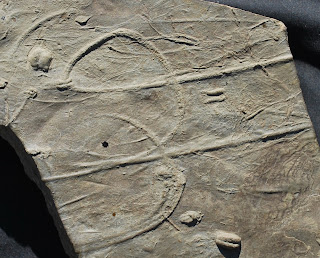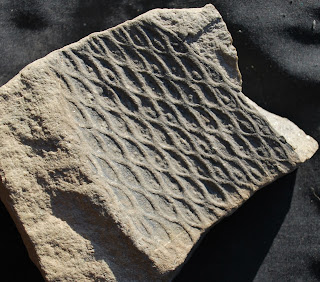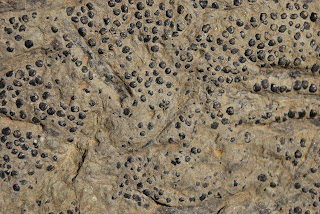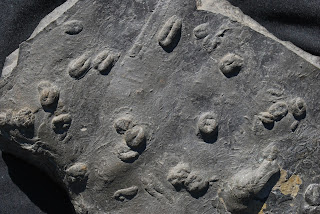Rarely Seen Yet Commonly Found
a glimpse of rare 350 million year old
Fossils of Blue Beach , Nova Scotia Canada
The Wave Ripples
Sedimentary
structures indicating subaerial conditions: Wave ripples
formed near shorelines much as they do today. They were
covered with mud and silt, preserving the ancient ripples.
The Mudcracks
Secondary
sedimentary structures: Mudcracks form after sediment deposition and
they indicate a significant period of drying, because of its exposure
to sun and air.

The Raindrops
Surficial
impressions indicating subaerial conditions: These exquisite markings
are only preserved in ideal circumstances, rarely seen.
Scratches
Intermittent
Tool-marks: Most tool-marks were caused by an interaction between
dead branches and shallow water currents.

Recurved Scratches
Parallel Linear Scratches
Unidirectional
currents: These are most common tool-marks representing typical longshore
drift.


Bark Impression
Lycopsid
trees: Commonly found as simple compressions in the sandstones and siltstones,
and represent one of the earliest forested wetlands.
Tree Branches
Compressions:
The early Mississippian species 'Lepidodendropsis
corrugatum' is the dominant tree in the paleoflora.
Mega Spores
Dense
accumulations: A rich assemblage of these spores indicate there was a far
greater diversity of plant life than the macrofossil record would suggest.
Plant Rootlets
Stigmaria: Commonly
found in situ as the
roots remained buried in the sediments where they originally grew.

Coastal Marsh Floras
Archaeocalamites
plant: Colonization by nearshore plant communities was soon followed by
true wetland-forest communities, a sign that marshes were an important step in
the development of terrestrial ecosystems.
Strobilus
Plant
Fructification: Furtile and unfurtile branches and stems are common components
in Paleozoic land floras. Preservation can vary, as seen by this
entumbed-form.


Worm Tubes
Natural
sandstone casts: Healthy populations of burrowing worms created elaborate
systems of tunnels in the sediments in times of slighty deeper waterlevels.
Rusophycus
Resting
trace of a short-bodied arthropod: Trails and resting places of various
arthropods are present and account for a diverse community of
non-vertebrate animals not known from their body fossils.
Bone Beds
Dense
accumulations: Fish scales, skeletal parts and teeth cover entire bedding-plane
surfaces in the deposit at Blue
Beach

Rhizodont Tooth
Sarcopterygian
fish: Giant predatory fish with alligator-like dental morphology often shed
their teeth throughout their lives, seen by the abundance of fossils
like the example above. Other fossilized parts of their skeletons are important
finds.
Rhizodont Fish Scale
Rhizodonts
were covered in thin scales which meant their bodies were highly
flexible throughout their length and relatively lightweight. As
unchanllenged masters of the early coal-swamps, speed was an advantage while
armour was unnecessary.
Tetrapod Limb Bones
Famora
of Stem Tetrapoda: Blue
Beach
Tetrapod Footprints and Trackways
Unlike
their rarely found bones, signs of their behaviours left a rich trace-fossil
record at Blue Beach ,
represented by over 2000 slabs of rock containing tracks in the collection at Blue Beach
~~~~~~~~~~~~~~~~~~~~~~~~~~~
Thank you for reading about our fossils! We hope you get a
chance to visit Blue Beach ,
Nova Scotia Canada
If you would like to know more about the Blue Beach












